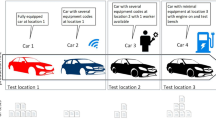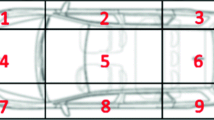Abstract
Currently, modern companywide PC networks usually possess significant unused calculation capacity. Since the connected personal computers are mainly used for office applications, considerable off-peak times occur. Consequently, in order to solve planning problems more efficiently, it is promising to apply distributed search procedures that make use of those available off-peak times. This applies in particular to complex problems where insights into the structure of the solution space are lacking. The paper at hand illustrates the application of distributed search methods to automotive assembly line balancing. Modern mass customization programs in the automotive industry frequently comprise more than a billion theoretical variants. Since this causes an oscillating capacity demand at the line, deliberately designing the layout of a mixed-model assembly line is of significant importance. The paper at hand provides a new mixed-model assembly line balancing approach that integrates specific aspects relevant for the automotive industry. However, by integrating several \({{\mathcal NP}}\) -hard subproblems like a detailed personnel planning or a flexible process planning of each task, the resulting model has significant complexity. Consequently, in order to find appropriate line layouts in reasonable time, specifically designed distributed solution approaches are provided and evaluated. Among these approaches, particularly the use of a specific clustered Tabu Search algorithm attains promising results. By making use of an adaptive dynamic load balancer, substantial improvements of the solution quality can be obtained even under unfavorable circumstances like oscillating background loads in the PC network.
Similar content being viewed by others
References
Amen M, (2006). Cost-oriented assembly line balancing: model formulations, solution difficulty, upper and lower bounds. Eur J Oper Res 168:747–770
Askin RG, Zhou M, (1997). A parallel station heuristic for the mixed-model production line balancing problem. Int J Prod Res 35:3095–3105
Becker C, Scholl A, (2006). A survey on problems and methods in generalized assembly line balancing. Eur J Oper Res 168:694–715
Blecker T, Abdelkafi N, Kaluza B, Kreutler G (2004) A framework for understanding the interdependencies between mass customization and complexity. In: Proceedings of the 2nd international conference on business economics, management and marketing, Athens/Greece, pp 1–15
Bock S, (2005). Solving complex QAP-instances by a PC-LAN. In: Günther et al. (eds) Supply chain management und logistik: optimierung, simulation, decision support. Physica, Heidelberg, pp 531–552
Bock S, Rosenberg O, (2000). A new parallel breadth first tabu search technique for solving production planning problems. J Int Trans Oper Res (ITOR) 7:625–635
Bock S, Rosenberg O, van Brackel T, (2006). Controlling mixed-model assembly lines in real-time by using distributed systems. Eur J Oper Res 168:880–904
Bukchin J, (1998). A comparative study of performance measures for throughput of a mixed model assembly line in a JIT environment. Int J Prod Res 36:2669–2685
Bukchin J, Masin M, (2004). Multi-objective design of team oriented assembly systems. Eur J Oper Res 156:326–352
Bukchin J, Dar-El EM, Rubinovitz J, (2002). Mixed model assembly line design in a make-to-order environment. Comput Ind Eng 41:405–421
Da Silveira G, Borenstein D, Fogliatto FS, (2001). Mass customization: literature review and research directions. Int J Prod Econ 72:1–13
Domschke W, Klein R, Scholl A, (1996). Antizipative Leistungsabstimmung bei moderner Variantenfließfertigung. Z Betriebswirtschaft 66:1465–1491
Duray R, Ward PT, Miligan GW, Berry WL, (2000). Approaches to mass customization: configurations and empirical validation. J Oper Manage 18:605–625
Fisher ML, Ittner CD, (1999). The impact of product variety on automobile assembly operations: empirical evidence and simulation analysis. Manage Sci 45:771–786
Fogliatto FS, Da Silveira GJC, Royer R, (2003). Flexibility-driven index for measuring mass customization feasibility on industrialized products. Int J Prod Res 41:1811–1829
Fremery F (1991). Model-mix balancing: more flexibility to improve the general results. In: Pridham M, O’Brien C (eds). Production research: approaching the 21st century. Taylor & Francis, London, pp. 314–321
Glover F, Laguna M (1997) Tabu Search. Kluwer, The Netherlands
Guerriero F, Miltenburg J, (2003). The stochastic U-line balancing problem. Nav Res Logist 50:31–57
Karabati S, Sayin S, (2003). Assembly line balancing in a mixed-model sequencing environment with synchronous transfers. Eur J Oper Res 149:417–429
Kim YK, Kim JY, Kim Y, (2000). A coevolutionary algorithm for balancing and sequencing in mixed model assembly lines. Appl Intell 13:247–258
Kim YK, Kim JY, Kim Y, (2006). A endosymbiotic evolutionary algorithm for the integration of balancing and sequencing in mixed-model U-lines. Eur J Oper Res 168:838–852
Link C (1992) Bandabgleich bei variantenreicher Fließfertigung. Thesis at the University of Mannheim
Macaskill JLC, (1972). Production-line balances for mixed-model lines. Manage Sci 19:423–434
McMullen PR, Tarasewich P, (2005). A beam search heuristic method for mixed-model scheduling with setups. Int J Prod Econ 96:273–283
Merengo C, Nava F, Pozzetti A, (1999). Balancing and sequencing manual mixed-model assembly lines. Int J Prod Res 37:2835–2860
Miltenburg J, (2002). Balancing and scheduling mixed-model U-shaped production lines. Int J Flex Manuf Syst 14:119–151
Park SK, Miller KW, (1988). Random number generators: good ones are hard to find. Commun ACM 31:1192–1201
Piller F, Koch M, Möslein K, Schubert P (2003) Managing high variety: how to overcome the mass confusion phenomenon of customer co-design. In: Proceedings of the EURAM 2003 conference, Milan
Pinnoi A, Wilhelm WE, (1997). A family of hierarchical models for the design of deterministic assembly systems. Int J Prod Res 35:253–280
Pinto PA, Dannenbring DG, Khumawala BM, (1983). Assembly line balancing with processing alternatives: an application. Manage Sci 29:817–830
Revsine L, Collins DW, Johnson WB, (2004). Financial reporting and analysis 3rd edn. Pearson Prentice Hall, New Jersey
Rosenberg O (1996) Variantenmanagement. In: Kern W etal (eds). Handwörterbuch der Produktionswirtschaft 2nd edn. Schäfer-Pöschel, Stuttgart, pp. 2119–2129
Rosenberg O, Ziegler H, (1992). A comparison of heuristic algorithms for cost-oriented assembly line balancing. ZOR, Meth Models Oper Res 36:477–495
Scholl A, (1999). Balancing and sequencing of assembly lines 2nd edn. Physica, Heidelberg
Scholl A, Becker C, (2006). State-of-the-art exact and heuristic solution procedures for simple assembly line balancing. Eur J Oper Res 168:666–693
Sparling D, Miltenburg J, (1998) The mixed-model U-line balancing problem. Int J Prod Res 36:485–501
Thomopoulos NT, (1970). Mixed model line balancing with smoothed station assignments. Manage Sci 16:593–603
Vilarinho PM, Simaria AS, (2002). A two-stage heuristic method for balancing mixed-model assembly lines with parallel workstations. Int J Prod Res 40:1405–1420
Zhao X, Ohno K, Lau H-S, (2004). A balancing problem for mixed model assembly lines with a paced moving conveyor. Nav Res Logist 51:446–464
Author information
Authors and Affiliations
Corresponding author
Rights and permissions
About this article
Cite this article
Bock, S. Using distributed search methods for balancing mixed-model assembly lines in the automotive industry. OR Spectrum 30, 551–578 (2008). https://doi.org/10.1007/s00291-006-0069-9
Published:
Issue Date:
DOI: https://doi.org/10.1007/s00291-006-0069-9




